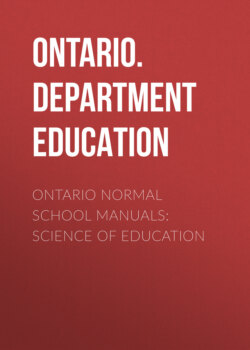Читать книгу Ontario Normal School Manuals: Science of Education - Ontario. Department of Education - Страница 43
На сайте Литреса книга снята с продажи.
GENERAL METHOD
ОглавлениеTable of Contents
Meaning of Method.—In the last Chapter it was seen that, in relation to the child, education involves a gaining of control over experiences. It has been seen further, that the child gains control of new experience whenever he goes through a process of learning involving the four steps of problem, selecting activity, relating activity, and expression. Finally it has been decided that the teacher in his capacity as an instructor, by presenting children with suitable problems, may in a sense direct their selecting and relating activities and thus exercise a certain control over their learning processes. To the teacher, therefore, method will mean an ability to control the learning process in such a way that the children shall, in their turn, gain an adequate control over the new experience forming the subject-matter of any learning process. Thus a detailed study by student-teachers of the various steps of the learning process, with a view to gaining knowledge and skill relative to directing pupils in their learning, constitutes for such teachers a study of General Method.
Subdivisions of Method.—For the student-teacher, the study of general method will involve a detailed investigation of how the child is to gain control of social experiences as outlined above, and how the teacher may bring about the same through instruction.
Tn such an investigation, he must examine in detail the various steps of the educative process to discover:
1. How the knowledge, or social experience, contained in the school curriculum should be presented to the child. This will involve an adequate study of the first step of the learning process—the problem.
2. How the mind, or consciousness, of the child reacts during the learning process upon the presented materials in gaining control of this knowledge. This will embrace a study of the second and third steps of the process—the selecting and relating activities.
3. How the child is to acquire facility in using a new experience, or in applying it to direct his conduct. This involves a particular study of the fourth step of the process—the law of expression.
4. How the teacher may use any outside agencies, as maps, globes, specimens, experiments, etc., to assist in directing the learning process. This involves a study of various classes of educational instrumentalities.
5. How the principles of general method are to be adapted to the different modes by which the learner may gain new experience, or knowledge. This will involve a study of the different kinds of lessons, or a knowledge of lesson types.
